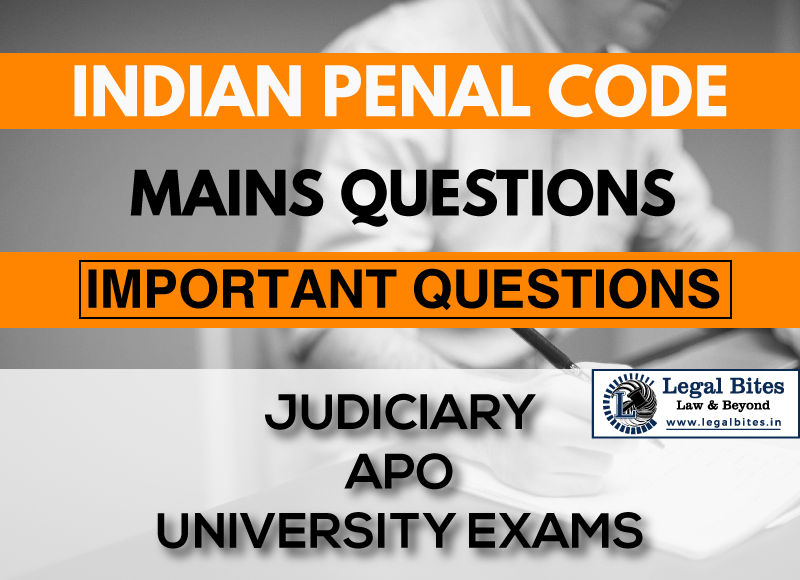In furtherance of the common intention A, B and C attacked D with Lathis. They gave various lathi blows on the person of D…
Find the answer to the mains question of IPC only on Legal Bites.

Question: In furtherance of the common intention A, B and C attacked D with Lathis. They gave various lathi blows on the person of D. During such attack C gave the last blow on the head of D which proved to be a fatal blow. Consequently, D died. A B and C were prosecuted for the murder of D under Section 302 read with Section 34, I.P.C. During the trial, A and B took the defence that they are not guilty of murder but only for causing hurt to D, as they did not give the fatal blow and only C...
Question: In furtherance of the common intention A, B and C attacked D with Lathis. They gave various lathi blows on the person of D. During such attack C gave the last blow on the head of D which proved to be a fatal blow. Consequently, D died. A B and C were prosecuted for the murder of D under Section 302 read with Section 34, I.P.C.
During the trial, A and B took the defence that they are not guilty of murder but only for causing hurt to D, as they did not give the fatal blow and only C is liable for the murder, who gave the fatal blow to D. Is the defence of A and B acceptable? Give reasons in support of your answer and also refer to the case law, if any, on the point.
Find the answer to the mains question of IPC only on Legal Bites. [In furtherance of the common intention A, B and C attacked D with Lathis. They gave various lathi blows on the person of D. During such attack C gave last blow on the head of D which proved to be a fatal blow. Consequently, D died. A, B and C were prosecuted for the murder of D under Section 302 read with Section 34, I.P.C.
During the trial, A and B took the defence that they are not guilty of murder but only for causing hurt to D, as they did not give the fatal blow and only C is liable for the murder, who gave the fatal blow to D. Is the defence of A and B acceptable? Give reasons in support of your answer and also refer to the case law, if any, on the point.]
Answer
The “Criminal Act” is the whole series of acts as, what Lord Sumner called, “unity of criminal behaviour” in Barendra Kumar v. Emperor, AIR 1923 PC 1 (C). If A and B go to the place of X with an intention to beat him and A gives him three blows with a lathi and B two blows with a spear, the criminal act comprises of their going to the place of X and the infliction of five blows with the weapons. If Section 34 applies, A will be punished as if he alone had done the whole act and similarly B will be punished as if he alone had done the whole act.
Similarly, in Loyd v. U. S., (1892) 35 Law Ed 1077 (S) it was held that if a number of persons agree to commit, and enter upon the commission of a crime which will probably endanger human life such as robbery, all of them are responsible for the death of a person that ensues as a consequence.
The facts of the present case resemble that of Bashir v. State, AIR 1953 All 668. In this case, the facts follow as: Angan and Majid reaped the crops of the field and stored them in the field. Bashir and his sons were at that time reaping crops of their field. When next morning Angan and Majid went to their field they found that some of their crops were missing. So they questioned the appellant and his sons who were in their field about the missing crops.
This offended the appellant and his sons who abused Majid and Angan and rushed at them with lathis and beat them. Angan getting two blows with a lathi stood apart while Majid was struck and knocked down with lathis by the appellant and his sons and he died in consequence of the blows on the head.
The Allahabad HC rightly observed that Section 34 applies in the present case and that the appellant and his sons all committed the offence of Section 302, Indian Penal Code. The accused formed the common intention of assaulting Majid with lathis. All the blows inflicted by all were inflicted in concert and in furtherance of the common intention. The result of all the acts done by all was the commission of the offence of murder; all of them are, therefore, responsible for the murder. Appellants A and B should therefore be, rightly convicted under Section 302/34 IPC.
Important Mains Questions Series for Judiciary, APO & University Exams
- IPC Mains Questions Series Part I: Important Questions
- IPC Mains Questions Series Part II: Important Questions
- IPC Mains Questions Series Part III: Important Questions
- IPC Mains Questions Series Part IV: Important Questions
- IPC Mains Questions Series Part V: Important Questions
- IPC Mains Questions Series Part VI: Important Questions
- IPC Mains Questions Series Part VII: Important Questions
- IPC Mains Questions Series Part VIII: Important Questions
- IPC Mains Questions Series Part IX: Important Questions
- IPC Mains Questions Series Part X: Important Questions

Admin Legal Bites
Legal Bites Study Materials correspond to what is taught in law schools and what is tested in competitive exams. It pledges to offer a competitive advantage, prepare for tests, and save a lot of money.
